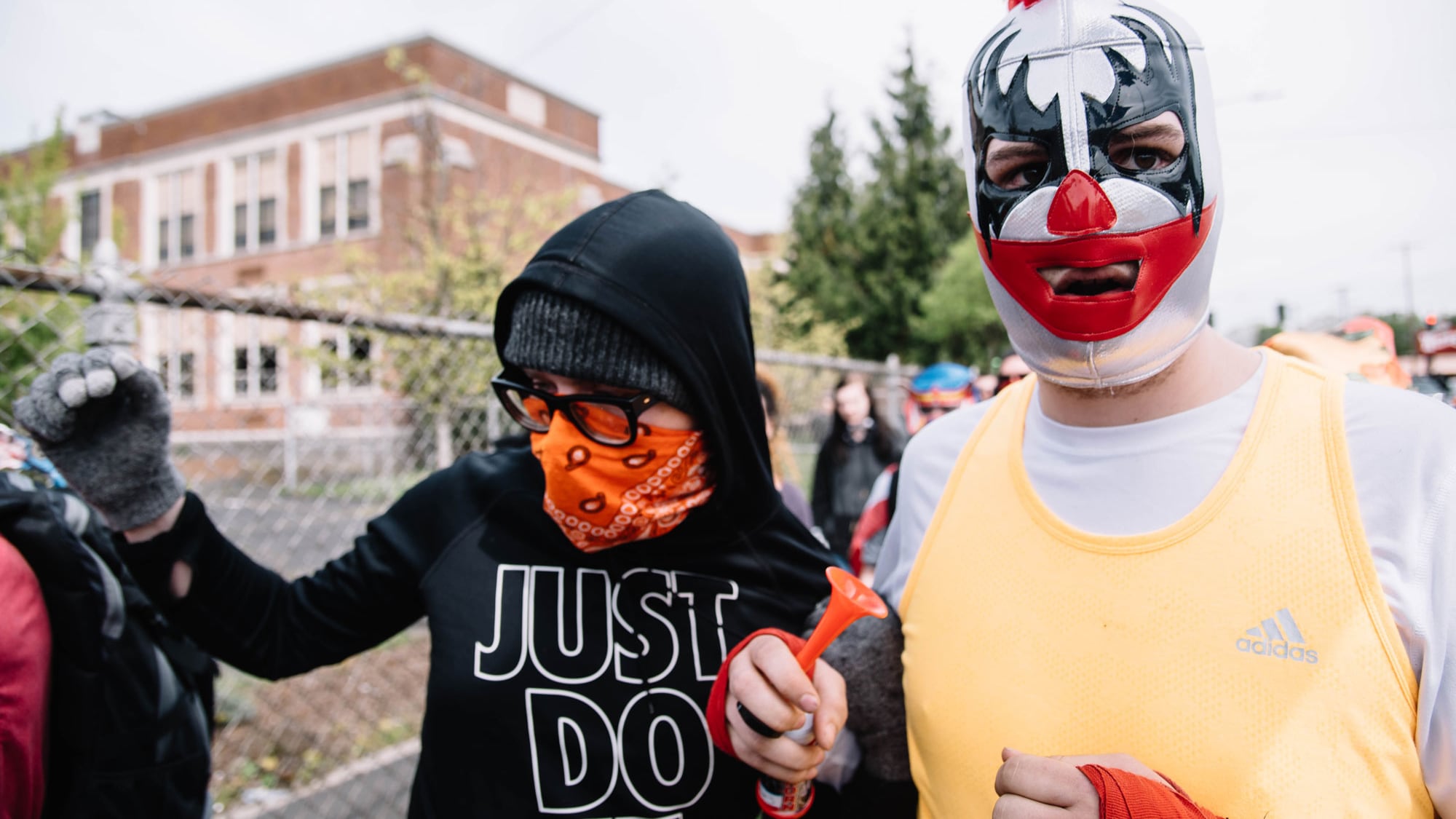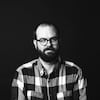On May 13, at about 4 pm, Tusitala "Tiny" Toese, a mountainous Samoan from Vancouver, Wash., decked another man in downtown Portland's Chapman Square.
Occasional acts of violence are a fact of life in any city. But this punch was different. The assault, captured on video, embodied the intensity of the political hostility boiling over on Portland's streets.
Those streets are becoming a battleground—not just between protesters and cops, but also between right and left.
In the four months since the inauguration of President Donald Trump, the metro area has witnessed at least six rallies or marches where some segment of the extreme right and militant leftists have confronted each other in public spaces.
The showdowns are but a small segment of the political unrest in this city. Since Trump's election, Portland has been the site of at least 30 marches and rallies.
Those events have been largely peaceful. They have also featured high-profile clashes between riot police and anarchists, resulting in at least 160 arrests and an estimated $1 million in property damage.
But it's the encounters between competing political ideologies that display a new kind of fury.

On one side is an ad-hoc crowd of militant leftists—including anarchists, socialists and communists—who cast themselves as an anti-fascist front, or "antifa." They often dress in black clothing and ski masks, an unofficial uniform borrowed from an anarchist subculture often loosely described as the "black bloc."
On the other side is antifa's political opposite: a coalition of white supremacists, anti-government militia groups and online agitators known as the "alt-right."
Their next skirmish could unfold in the middle of the Rose Festival.
On June 4, Kyle Chapman plans to lead a rally across from Portland City Hall. Chapman is an online celebrity from California who has attracted a wide following for battling left-wing protesters, wearing a gas mask and armed with a large stick.
Chapman is coming to Portland at the behest of Joey Gibson, a Vancouver video blogger. Attendees of his Portland-area events this spring have included anti-gay street preachers, crews of bikers, and several people claiming affiliation with Confederate and neo-Nazi groups.
Chapman and Gibson have both gained a degree of prominence in the alt-right, a nationalist movement designed to provoke and taunt liberal "snowflakes" they see as undermining America.
On the street, the conflict between right and left can look absurd—like deleted scenes from the Mad Max movies.

Yet in the wake of Trump's election, brawls between dozens of adherents of alt-right and antifa movements have become regular events in cities from Boston to Berkeley, Calif.
"It's never been as vocal as it has been in recent months," says Portland Police Bureau spokesman Sgt. Pete Simpson. "While they're not street gangs, the threat of violence is there. They're challenging each other—calling each other out."
Alt-right-led events with the title "March 4 Trump" began occurring around Portland two months ago, starting in Lake Oswego and Vancouver.
Last month, the 82nd Avenue of Roses Parade was canceled after an anonymous email threatened a mass assault of alleged white supremacists who were rumored to be planning to march.
Since that uproar, alt-right groups have twice come to Portland for tense standoffs with local leftists.
Longtime observers of extremism hear echoes of old Portland violence.
"This is a manifestation of a long-simmering battle between the extreme right and the extreme left in this town," says Randy Blazak, chairman of the Oregon Coalition Against Hate Crime. "It led Portland to be dubbed 'Skinhead City' in the 1990s. Thanks to the sea change of the 2016 election season, it's back in full force."

The workings of alt-right groups are mysterious—often by design.
Many members use their real names, but refuse to give straight answers on anything else.
One of the most visible alt-right leaders in the Pacific Northwest is Joey Gibson, 33, who lives in Vancouver. He casts himself as a champion of free speech. His public pronouncements and YouTube videos seek to get right-wing allies riled up to "trigger some snowflakes"—meaning, taunt and provoke liberal and leftist college students.
Gibson tells WW he is "promoting freedom, through the power of prayer," he says. "It's kind of a spiritual movement."
In April, Gibson traveled to Berkeley, where he posed for videos with Kyle Chapman, a 41-year-old commercial diver and YouTube personality.

Chapman's fans call him "Based Stickman," which means a badass guy with a stick. Chapman was filmed at the Berkeley "March 4 Trump," breaking a signpost over the head of a left-wing protester. He was arrested on suspicion of felony assault with a deadly weapon, among other charges. An online campaign raised $50,000 for his bail and legal defense.
Chapman did not respond to WW's requests for comment. In a March 31 profile in The New Republic, he said he was a conservative Republican and uncomfortable with some of his extreme admirers. But he pledged to keep going into new cities to confront leftists.
Alexander Reid Ross, a Portland State University geography instructor who recently published a book on fascist and antifa struggles, Against the Fascist Creep, says alt-right agitators see Berkeley, Seattle and Portland as targets.
"They think by making incursions into 'enemy' territory and demoralizing them—by beating them up or mocking them relentlessly—they'll be able to throw off the assumptions that underlie society," Ross says. "They see it as a civil war."

The alt-right is shady about its affiliations and intentions.
Their anti-fascist opponents are clearer about their goals, but resolutely anonymous.
The roots of antifa—the local wing is called Rose City Antifa—lie in left-wing brawlers who organized in Cold War Germany, as well as in the underground punk-rock scene of Portland in the 1980s and '90s.
In 1988, in an event that seared this city's residents, Ethiopian student Mulugeta Seraw was beaten to death by white-supremacist skinheads. That event helped give rise to a group of "anti-racist" skinheads, the forebears of today's antifa.

"In one sense, this is nothing new," says Blazak. "These guys have been going at it for years. They put on new haircuts, and they do battle in the streets of Portland."
Rose City Antifa declined repeated requests for comment.
But WW's reporting—conversations with people at events, as well as interviews with longtime observers of the movement—indicates that affiliates include middle-aged, gainfully employed veterans of the anti-racist skinhead scene, as well as college student activists and kids as young as 14. It's difficult to say how many people are involved in antifa movements in Portland, but crowd estimates at marches suggest it's as many as 200 people.

Ross says Portland's antifa groups play a key role in discouraging the rise of racist violence and intimidation. "It has become shorthand for people who want to go out and fight Nazis," he says. "The alt-right has to be understood as a fascist movement."
In their black bloc-style outfits, which they have worn four times in the past four months, it is difficult to distinguish these anti-fascist groups from more familiar anarchist protesters—or from thrill-seeking teenagers who see an opportunity to throw Pepsi cans at cops or smash store windows.
Marco Mejía, an organizer with Portland Immigrants Rights Coalition and the emcee of this year's May Day rally, says he has mixed feelings about antifa actions.
"I don't condemn people who feel like they need to protect themselves and the community," he says. Still, "there should be better communication."

On May 13, a day of thunderstorms and hailstones, Gibson and his antifa foils faced off in Portland's Chapman Square, located at Southwest 3rd Avenue and Main Street.
The event kicked off a block south with an anti-police brutality protest called by a Facebook group named Oregon Students Empowered. About two dozen left-wing protesters showed up, most wearing masks and black clothing.
Gibson, the pro-Trump organizer from Vancouver, also arrived with his crew, also numbering about two dozen. Within 15 minutes, the sides squared off.

Portland police officers observed silently, but then left. After about an hour of shouting, the left-wing group crossed the street. One of them set fire to a U.S. flag. (Others quietly objected.) Gibson's crew took the flames as their cue to begin the confrontation anew.
People from each side began screaming insults at each other as a circle of observers live-streamed the confrontations. Within minutes, Gibson's friend, Tiny Toese, the 20-year-old American Samoan, flattened an antifa protester half his size with a punch to the face, while the kid had his arms crossed defensively.
Portland police soon returned. Sgt. Jeffrey Niiya calmly questioned representatives from both groups. Niiya appeared familiar with individuals on both sides. "It's my job," he explained.
Gibson, who stresses how much his group supports law enforcement, appealed for sympathy, but Niiya was skeptical. "Some of the people on your side are inflaming the other side on social media," Niiya told Gibson.
"The problem is, we have outsiders," Gibson said. "I'm here to be respectful and to talk to them."
Niiya told antifa protesters that for police to make an arrest, the victim would need to provide his name. After some chatter in the group, the word came back via the human megaphone: "No victim!" The police decamped a second time from the park.

Later that afternoon, Toese returned home and recorded a video for his Facebook page calling the day a success.
"We don't come there to fight. Our goal is to educate," Toese said. "I know it turned a little bit ugly. I had to do what you guys saw me do. But please, everybody, that is not who I am. Don't take me as a violent person. I am just a big, happy Samoan. A brown brother for Donald Trump and a brown brother for America."
Toese also expressed eagerness for the next big brawl—evidently the June 4 rally starring Kyle Chapman.
"We got another event that's coming up," he went on. "You guys will see us there. That event is on my birthday. So I guess I'm going to be celebrating my birthday kicking some antifa ass."

June 4 falls in the second week of the Rose Festival, Portland's biggest annual family event.
The home page of the Rose Festival website currently reads: "Business as Usual."
"Recent events in Portland have led to rumors that the Rose Festival is considering canceling its popular parades due to safety concerns," the site says. "This is not true."
Mayor Ted Wheeler's office says he has instructed police to keep calm—and try to pacify the adversarial groups.
"Police try to work with organizers and try to head off any conflict before it happens," says Wheeler spokesman Michael Cox. "I know they're doing that work now with regard to June 4. Of course, their success depends in large part on the organizers' cooperation and communication before an event. Sometimes they get it. Sometimes they don't."

Meanwhile, a U.S. Department of Homeland Security memo sent to Democratic Oregon Sen. Ron Wyden on March 24 shows the federal government is keeping close watch on Portland—at least on one side of the political spectrum.
The memo, obtained last month by WW, confirms earlier reports that the feds are classifying property damage by left-wing protesters as "domestic terrorism."
"Rioting by violent anarchist extremists at events [last November] met the criteria" for terrorism, Acting Under Secretary for Intelligence and Analysis Patricia F.S. Cogswell wrote to Wyden. "DHS has a duty to report and analyze such acts of ideologically motivated violence."
Wyden says Homeland Security's distinction between property damage and political protest is somewhat reassuring.
"DHS said the right things here," Wyden tells WW, "but I'm going to be watching closely to make sure this administration doesn't blur the line between watching out for real domestic threats and targeting peaceful protesters who are exercising their constitutional rights."

Wheeler dismisses the concept of Portland protesters as terrorists.
"The mayor does not view protesters as domestic terrorists," says Cox. "As with so many things with the federal government today, Portland is going to continue with our strategy: honoring First Amendment rights while not tolerating acts of violence, vandalism or blocking transit."
By contrast, Homeland Security hasn't made any public statement about alt-right groups, even after well-documented violence in Berkeley. A unit involved in countering right-wing extremism has been disbanded.
Even so, police spokesman Simpson pledges his agency won't play favorites.
"We aren't there to protect one group and arrest another," he says. "We're out there to keep these two groups away from each other. We'd like to see cooler heads prevail, and for people to realize there is no changing each other's mind out in the streets."
Mike Bivins contributed reporting to this story.

Correction, May 24: The print edition of this story incorrectly attributes an interview with Kyle Chapman to the National Review instead of its actual source, The New Republic. WW regrets the error.
The nonprofit WW Fund for Investigative Journalism provided support for this story.


